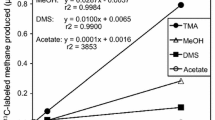Abstract
An ecological substrate relationship between sulfate-reducing and methane-producing bacteria in mud of Lake Vechten has been studied in experiments using 14C-labeled acetate and lactate as substrates. Fluoroacetate strongly inhibited the formation of 14CO2 from [U-14C]-acetate and β-fluorolactate gave an inhibition of similar magnitude of the breakdown of [U-14C]-l-lactate to 14CO2 thus confirming earlier results on the specific action of these inhibitors.
The turnover-rate constant of l-lactate was 2.37 hr-1 and the average l-lactate pool size was 12.2 μg per gram of wet mud, giving a turnover rate of 28.9 μg of lactate/gram of mud per hr. The turnover-rate constant of acetate was 0.35 hr-1 and the average pool size was 5.7 μg per gram of wet mud, giving a rate of disappearance of 1.99 μg of acetate/gram of mud per hr. Estimations of the acetate turnover rate based upon the formation of 14CO2 from [U-14C]-acetate or [1-14C]-acetate yielded figures of the same magnitude (range 0.45 to 1.74). These and other results suggest that only a portion of the lactate dissimilated is turned over through the acetate pool.
The ratio of 14CO2/14CH4 produced from [U-14C]-acetate by mud was 1.32; indicating that 0.862 moles of CH4 and 1.138 moles of CO2 are formed per mole of acetate. From the rate of disappearance of acetate (0.027 μmoles/gram wet mud per hr) and the rate of methane production (0.034 μmoles/gram wet mud per hr), it may be concluded that acetate is an important precursor of methanogenesis in mud (approximately 70%). A substrate relationship between the two groups of bacteria is likely since 14CH4 was formed from [U-14C]-l-lactate.
Similar content being viewed by others
References
Cappenberg, Th. E. 1974a. Interrelations between sulfate-reducing and methane-producing bacteria in bottom deposits of a fresh-water lake. I. Field observations. — Antonie van Leeuwenhoek 40: 285–295.
Cappenberg, Th. E. 1974b. Interrelations between sulfate-reducing and methane-producing bacteria in bottom deposits of a fresh-water lake. II. Inhibition experiments.— Antonie van Leeuwenhoek 40: 297–306.
Gray, F. V., Jones, G. B. and Pilgrim, A. F. 1960. The rates of production of volatile fatty acids in the rumen.— Austr. J. Agric. Res. 11: 383–388.
Hall, K. J., Kleiber, P. M. and Yesaki, I. 1972. Heterotrophic uptake of organic solutes by microorganisms in the sediment.— Mem. Ist. Ital. Idrobiol. 29, Suppl.: 441–471.
Harrison, M. J., Wright, R. T. and Morita, R. Y. 1971. Method for measuring mineralization in lake sediments.— Appl. Microbiol. 21: 698–702.
Hungate, R. E., Smith, W., Bauchop, T., Yu, I. and Rabinowitz, J. C. 1970. Formate as an intermediate in the bovine rumen fermentation.— J. Bacteriol. 102: 389–397.
Jeris, J. S. and McCarty, P. L. 1965. The biochemistry of methane fermentation using C14 tracers.— J. Water Poll. Control Feb. 37: 178–192.
Knox, K. L., Black, A. L. and Kleiber, M. 1967. Some kinetic characteristics of rumen short-chain fatty acids as measured by the isotope dilution method.— J. Dairy Sci. 50: 1716–1720.
Lawrence, A. W. and McCarty, P. L. 1969. Kinetics of methane fermentation in anaerobic treatment.— J. Water Poll. Control Fed. 41: R1-R17.
Smith, P. H. and Mah, R. A. 1966. Kinetics of acetate metabolism during sludge digestion. — Appl. Microbiol. 14: 368–371.
Sorokin, Y. I. and Kadota, H. (eds.) 1972. Techniques for the assessment of microbial production and decomposition in fresh waters.—IBP Handbook 23. Blackwell, Oxford.
Wood, L. W. and Chua, K. E. 1973. Glucose flux at the sediment-water interface of Toronto Harbour, Lake Ontario, with reference to pollution stress.— Can. J. Microbiol. 19: 413–420.
Author information
Authors and Affiliations
Rights and permissions
About this article
Cite this article
Cappenberg, T.E., Prins, R.A. Interrelations between sulfate-reducing and methane-producing bacteria in bottom deposits of a fresh-water lake. III. Experiments with 14C-labeled substrates. Antonie van Leeuwenhoek 40, 457–469 (1974). https://doi.org/10.1007/BF00399358
Received:
Issue Date:
DOI: https://doi.org/10.1007/BF00399358




